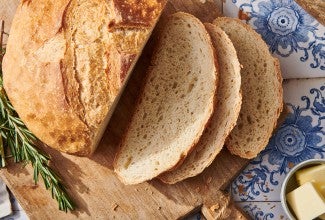-
Weigh your flour; or measure it by gently spooning it into a cup, then sweeping off any excess.
-
To make the poolish: Combine the flour, water, and yeast. Cover the container and allow to rest for 12 to 16 hours at room temperature. When the poolish is ready to use, it will be doubled in size, and filled with large bubbles.
-
To make the dough: Add the water to the poolish. Add the flour, mix to combine, cover the bowl, and allow the mixture to rest for 20 minutes. This rest period (autolyse, in French) allows the flour to absorb the liquid and the gluten to start its development, making kneading easier and more effective.
-
Add the yeast and salt, and knead the dough until it's fairly smooth, about 5 to 7 minutes by hand, 3 to 4 minutes by electric mixer, or 5 to 7 minutes in a bread machine. The gluten will continue to develop as the dough rises, so you don't want to develop it fully during the kneading process.
-
Place the dough in a lightly greased bowl, cover the bowl, and allow the dough to rise, at room temperature, for 1 1/2 hours. To help develop the gluten, distribute the yeast's food, and expel any excess carbon dioxide, turn the dough every 30 minutes during the rising time: gently fold all four sides into the middle, and turn the dough over.
-
Transfer the dough to a lightly greased work surface, divide it in half, shape each half into a rough log, cover them, and let them rest for 15 to 20 minutes. This allows the gluten to relax, making it easier to shape the bread.
-
Shape the logs into batards (shorter and fatter than traditional French baguettes) or Italian-style loaves — tapered ovals about 12" long.
-
Place the loaves on a lightly greased or parchment-lined baking sheet, cover them with lightly greased plastic wrap, and allow them to rise at room temperature for about 2 hours; they should be puffy but not doubled.
-
When the loaves are nearly done rising, preheat the oven to 425°F.
-
Using a sharp knife or razor, and holding it at a 10° to 20° angle, make four slashes in each loaf. These should be nearly vertical to the loaf, each about 1/3 the length of the loaf. The beginning of each cut will run parallel to the previous cut by 1/3 the length of the cut. Spray the loaves with warm water.
-
Bake the bread for 30 to 35 minutes, or until the loaves are a deep, golden brown. European-style loaves are generally baked longer than American loaves; if you're uncomfortable with a very dark crust, reduce the baking time a bit.
-
Like any loaf made without fat, these become stale very quickly. So bake and eat them the same day or, if they're day-old, reheat them for 5 to 10 minutes in a preheated 350°F oven.




















